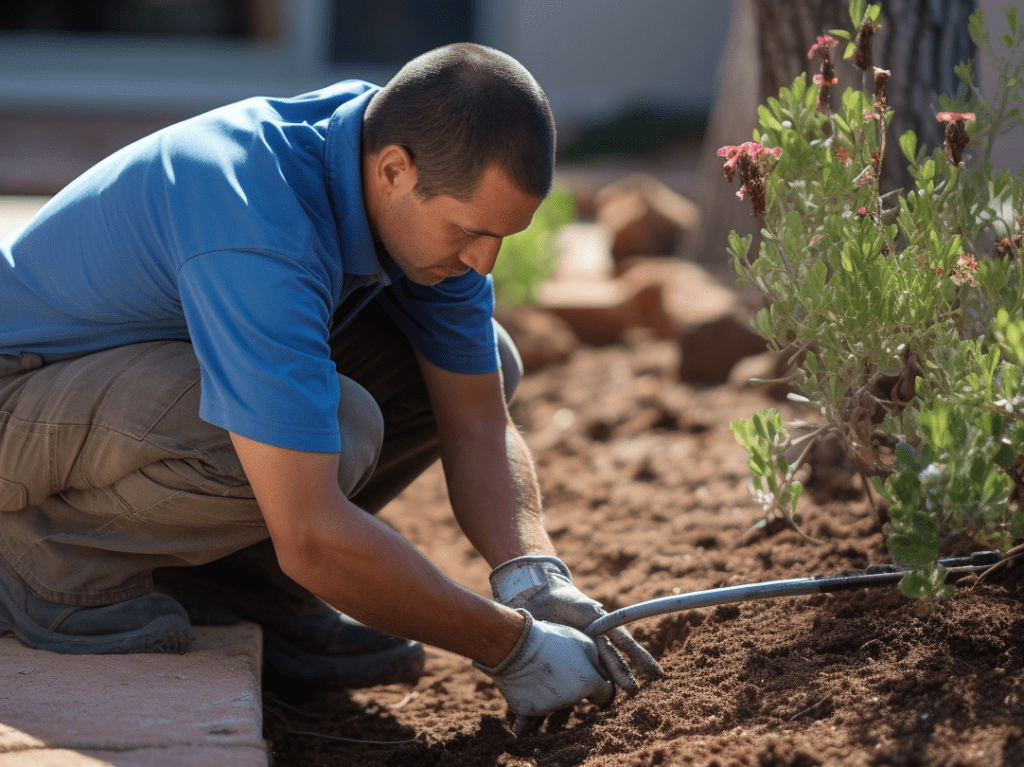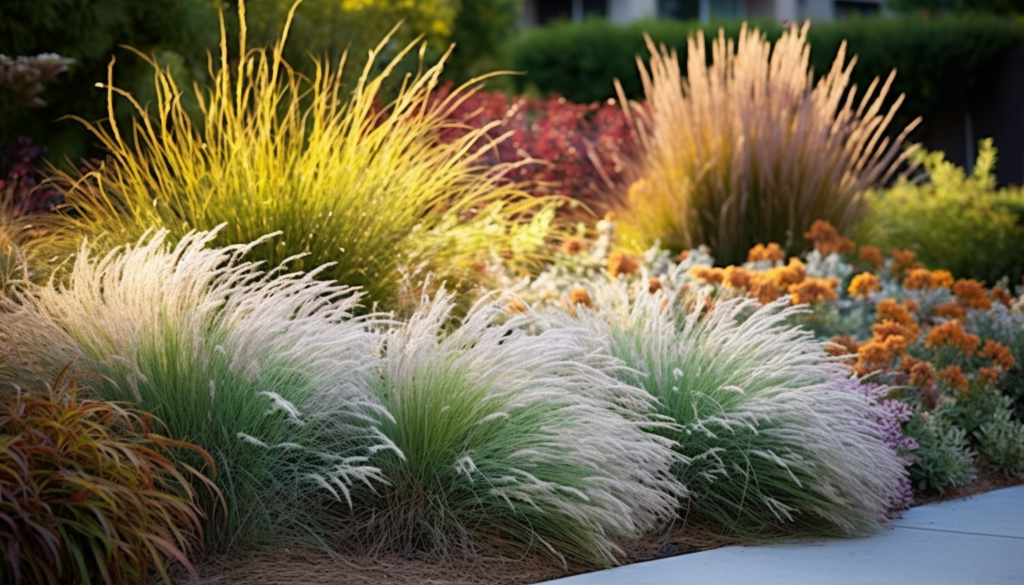Looking for front yard ideas to build your own bold xeriscape and be the envy of the neighborhood? In today’s environmentally conscious world, xeriscaping has emerged as a popular landscaping approach that promises not only water conservation but also an aesthetically pleasing outdoor space. Xeriscaping, derived from the Greek word “xeros” (meaning dry), involves designing landscapes that require minimal irrigation and maintenance. Below we will delve into the art of xeriscaping, exploring its benefits, challenges, and providing some ideas to create a stunning xeriscape front yard.
What is Xeriscaping?
Xeriscaping is a landscaping philosophy that prioritizes water efficiency and sustainability. At its core it involves selecting drought-tolerant plants, utilizing natural elements, and implementing smart design practices to minimize water usage and environmental impact. By carefully planning and designing a xeriscape front yard, homeowners can reduce water bills ($$!), conserve precious water resources, and create a beautiful, eco-friendly outdoor oasis.
Benefits of Xeriscaping:
- Water Conservation: Those who support xeriscaping say that it can significantly reduce water consumption by up to 50-75%, making it an eco-conscious choice in regions prone to drought or water scarcity.
- Low Maintenance: Once established, xeriscape front yards require less maintenance and resources, saving homeowners time, effort, and money.
- Environmental Benefits: Xeriscaping supports biodiversity by encouraging the use of native plants that provide food and habitat for local wildlife, including pollinators.
- Enhanced Curb Appeal: A thoughtfully designed xeriscape front yard can be just as visually appealing as traditional landscapes, with the added bonus of sustainability.
Challenges of Xeriscaping:
While xeriscaping offers numerous advantages, it also comes with some challenges. The most common obstacles include finding the right balance between aesthetics and functionality, addressing soil and drainage issues, and dealing with potential resistance from HOAs and traditional landscaping norms/expectations. However, with careful planning and creativity, these challenges can be overcome to achieve a beautiful and thriving xeriscape front yard.
Tips and Ideas for a Xeriscape Front Yard
Consider Your Climate: First and foremost, it is critical to understand the unique challenges and opportunities of your region’s climate when choosing plants and design elements. Some questions to get you started:
- What hardiness zone are you in?
- How much sun does your front yard get?
- How often does it rain and what time of year?
- How hot does it get in the summer?
- How cold does it get in the winter?
Irrigation Systems and Other Water-Conserving Features: Install drip irrigation or soaker hoses to deliver water directly to the root zones of plants, minimizing wastage and maximizing efficiency. Drip irrigation can be installed on its own or there are ways to convert existing sprinklers to more water-efficient alternatives. Additionally, consider rainwater harvesting systems to capture and reuse rainwater for irrigation purposes, further reducing your water footprint.

Embrace Native Plants: Selecting native plants that are naturally adapted to your region’s climate is the foundation of a successful xeriscape front yard. Look for drought-tolerant species such as yuccas, agaves, and various types of ornamental grasses. Native plants not only thrive with minimal irrigation but also provide essential habitat and food sources for local wildlife.
Xeric-Friendly Trees: Plant shade-providing trees that are well-suited to arid conditions, such as mesquites or desert willows. These trees offer cooling benefits, reduce water loss from the soil, and add height and character to your xeriscape front yard.
Introduce Ornamental Grasses: Ornamental grasses are excellent additions to a xeriscape front yard, offering graceful movement, texture, and year-round interest. Many grass varieties are drought-tolerant and require minimal care, making them a fantastic choice for water-wise landscaping.

Mindful Use of Color: Thoughtfully incorporate colors into your xeriscape front yard to create a vibrant and welcoming space. Seek out drought-tolerant flowering plants in various hues and consider a color palette that complements your home’s exterior.
Attract Beneficial Insects: Include plants that attract beneficial insects like bees, butterflies, and ladybugs, as they aid in pollination and natural pest control. These insects contribute to a balanced ecosystem and improving the environment for local wildlife, supporting the overall health of your xeriscape front yard.
Layering and Grouping: Optimize water use and create visual interest by designing your xeriscape front yard with layered planting. Use a mix of plant heights and textures to create an attractive landscape and add visual depth in your xeriscape design. Also be conscious to group plants with similar water needs together, creating microclimates that support each other’s growth while minimizing water waste.
Water-Saving Mulch: Apply organic mulch to retain soil moisture, reduce evaporation, suppress weeds, and create a polished, cohesive look for your xeriscape front yard. Mulch can be found at nurseries and home improvement stores, but be sure to check out your local government — often, a department will have a program dedicated to giving out free mulch.

Creative Use of Space: Utilize spaces in unique ways to help your property stand out, such as designing meandering pathways, seating areas that can be utilized by friends and family, or focal points to enhance the aesthetic appeal.
Incorporate Hardscaping: Use hardscaping elements like flagstone pathways, decorative gravel patios, and stone retaining walls to add structure and visual appeal to your xeriscape front yard. Hardscaping not only requires little to no water but also contributes to a low-maintenance landscape. Read more about hardscaping with rocks and gravel here, which includes some tips and ideas to get you started.

Decorative Rocks and Gravel: Incorporate decorative rocks and gravel throughout to add texture and visually break up the landscape while also reducing soil moisture loss.
Create a Rock Garden: Introduce a rock garden as a centerpiece of your xeriscape front yard. Use a mix of boulders, pebbles, and ornamental rocks to add visual interest and texture. This works particularly well in Southwestern climates where a rock garden complements the native surroundings. Nestle low-water plants among the rocks to soften the landscape and create a harmonious natural setting.
Lighting: While not directly related to conserving water, lighting is a great way to add dimension and aesthetic appeal to your space. Don’t have electricity hookups in your front yard? No worries as retailers like Amazon offer many solar-powered lighting options perfect for outdoor spaces. Check out our article here where we feature some products that could help add some character to your xeriscaped yard.
By implementing these tips and ideas for a xeriscape front yard, you can create a water-efficient, visually stunning, and sustainable landscape that brings pride and joy to your home while contributing to a more eco-friendly future. Please share your xeriscape front yard ideas in the comments below. Happy xeriscaping!
Have an idea for content? Get in touch, we’d love to chat.

